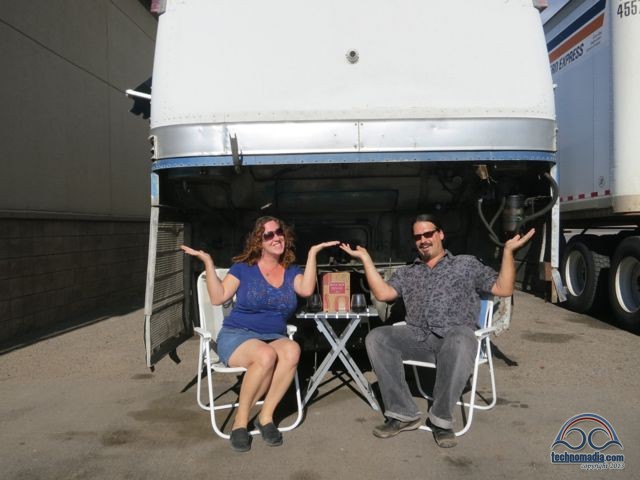
One concern that many people have about life on the road is this – how will you handle things if your ‘house’ breaks down?
This particularly comes up when considering the ‘towable vs motorhome’ question for the ideal full time RV to live in.
We’ve had both towable trailers and now a bus conversion motorhome. And we’ve had our share of breakdowns and trips to the shop in both.
Regardless of what form your home-on-wheels takes, needing extensive repairs is frustrating.. it abruptly changes your plans, usually takes a bit out of the savings fund, and generally just isn’t fun.
But it is all part of the adventure of this lifestyle.
So, we thought we’d share a bit about the trade-offs of each style of RV.. and some tips we’ve learned about living in a shop’s parking lot.
Towables vs Driveables
If you have a motorhome, and something with the drive train needs repairs – your whole house is immobile and potentially stuck ‘in the shop’.
The common perception is that being in the shop automatically means you’re kicked out of your house.
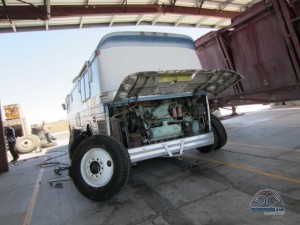
And while not every shop will let you continue to live in your home while they work on it, in our experience we’ve found this is more an exception than a rule.
So far there’s only been one time that we couldn’t overnight in our bus while it was undergoing work – when we were changing out our tires & wheels, and the shop ran into a problem that left us immobile and required a part being overnighted.
No problem, we just got on Hotwire.com and snagged a last minute affordable room in the area. Besides, it was 120 degrees out, and they didn’t have enough power to run our AC anyway.
So far however, all of our other overnight bus repairs & maintenance stops have been in locations where the shop was happy to toss us a power cord and let us live onsite.
In particular with our current extended repair, we specifically asked potential shops when we called around if we could do so. We knew that we were facing a multi week repair to get back on the road, and didn’t want to add a motel bill to the cost. Thankfully, not a single shop we asked had a problem with us being onsite.
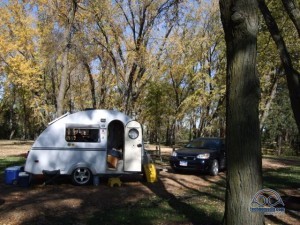
On the other hand – when we had a Jeep or truck pulling our trailers and we broke down – never once did we encounter an auto service shop that allowed us to park the trailer in their lot while they did the work. That’s not to say there might not be shops out there that would allow it, but I’d say this is a rule that may have some exceptions (opposite of truck repair places).
We had to find a way to get our house relocated somewhere to live at while repairs are done, and we had to rent or borrow a vehicle for the duration, or rely on public transit. Our Jeep’s transmission in particular had to be rebuilt twice during our travels, each time taking a week or more.
In our experience, it’s ended up being much less inconvenient living in a motorhome and needing drive train work than it was when we were in a trailer. We’ve also been blessed that, so far, all of the diesel shops we’ve stopped in have also allowed us in the shop to observe and learn from our mechanics.
Now, if you need extended RV system repairs – it may be a different story all around. Depending on the work and the shop, regardless if you have a motorhome or a towable – you have similar odds of being able to continue living onsite or needing to make other arrangements.
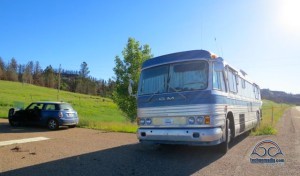
Another concern we often hear with having a motorhome is that you probably also want a towed behind vehicle (aka ‘toad’) for local transportation – which means maintaining two engines. For reference, we tow a MINI Cooper.
Let me tell ya, after breaking down in the middle of nowhere far from cellular signal we could utilize – we find the investment in maintaining two engines absolutely worthwhile. We never felt truly stranded and had our own power to get to where we could orchestrate help and make a rationale plan of action.
Had we still had a towable setup and our tow vehicle broke down similarly – we would have been far more dependent on the generosity of others to help stranded travelers. Not impossible, but it definitely would have required a whole other level of manifesting solutions.
Living in a Parking Lot
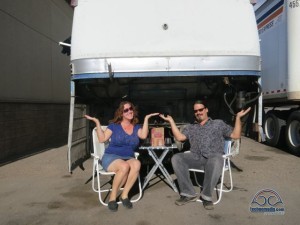
For the past two weeks, and probably for the next couple of weeks – we have been living in the parking lot of the shop doing our engine rebuild. When we called around shops, Interstate Power gave us directions on exactly where to have our wrecker drop us off at so that we could reach a power outlet.
While not the most scenic of places, it’s been wonderful being onsite – especially as we’ve been invited to shadow our techs. It’s allowed us to check in on the progress, compare research notes, learn about our engine and more – all with no commute, and being able to stay on top of our work and cat worshipping responsibilities.
And, our view is changing regularly despite us not moving – every couple hours a different truck, bus or fraking machine is pulled in next to us waiting to be worked on. It’s also fascinating to be exposed to such a large facility servicing oil field machinery, ranch equipment and more. We’re learning a lot.
Not to mention a heck of a lot cheaper than trying to find a weekly rental or motel in the area that would allow pets.
But, as we’re not at a full hook-up campground, it’s definitely not without livability compromises.
Here’s some of the things we’re doing to make this a more sustainable situation:
Power
While the shop has an outside power outlet we can run our heavy duty extension cord to, it’s just a standard household style outlet with a 20amp breaker.
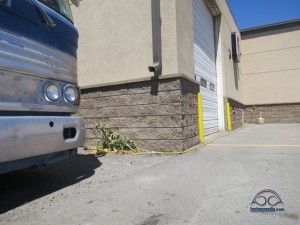
Definitely not enough to run everything in our bus, especially during the heatwave that has hit us the last few days. The temps have been rising into the lower 90s (I know I know, folks in the southwest would consider that a chilly day right now), which makes living in a metal tube on an asphalt parking lot with no shade extra challenging.
But thank goodness for our boosting inverter and 500AH lithium ion battery bank! We are definitely basking in the power independence of that investment.
We specifically setup our house energy system to be versatile for a variety of situations. The large battery bank & our Victron MultipPlus 3000w inverter can run an air conditioner, and all household basics, for a couple of hours while completely off grid.
The boosting feature of the inverter allows us to take advantage of external power sources (such as a regular wall outlet) and boost from the battery bank to supplement… allowing us to thrive off a limited power source, without blowing the shore power breaker when demands spike.
When the load isn’t there, the inverter goes back to recharging up the bank.
The result? We can keep a single roof air cranking all day long while only very slowly draining our battery bank. Supplement that with a small floor fan, and we’re keeping Kiki nicely chilled.
This has come in so handy so many times – such as being able to park the bus for the best view instead of where we could reach our 30a or 50a hookup with our big power cord. Or driveway surfing with friends & family who didn’t pre-think installing a RV plug in.
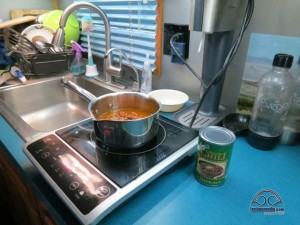
We however can’t run multiple high loads at once without exceeding our inverter’s capacity, so we do have to consciously manage our usage – such as only running the hot water heater (we are propane free now), AC, microwave or induction cooktop one at a time.
But, that’s not too much of a problem. Sure, it means to prepare a warm meal we have to turn off the AC. But at least with our awesome induction cooktop, it doesn’t add heat to the environment and cooks really quickly – making it so much more tolerable. (One of the many reasons we love love love our induction cooktop!)
For more information, check our article on the boosting inverter, and our series on our lithium ion battery bank (which we’re going on 2 years of use.. and we’re still thrilled with it!).
Note, since we wrote these articles – Magnum has now also released their boosting inverter, adding another option to the mix to check out.
Water & Sewer
Water hasn’t been much of a problem for us. We’re within 75′ of a water spigot source in the shop – so with enough hose we can reach that to keep our freshwater tank filled. We have a brand new water pump installed, that is happily keeping the shower, sinks and toilet flowing with great water pressure while not hooked directly up to a city water source.
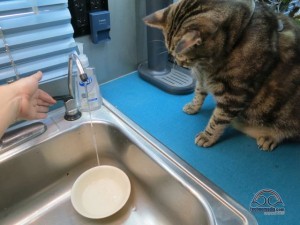
If water was much further away, we’d consider adding more hoses or getting some larger containers that we could then manually suck into the tank (a feature we built into our pump setup.)
However, sewer is a problem.
If there was a sewer clean-out or access point anywhere nearby – we might be moving ahead with our plans to install a macerator setup which would allow us to pump our waste water further away. But one can’t be found within a few hundred feet of where the bus is parked. And certainly not anything close-enough to consider using our standard stinky-slinky setup.
For more fascinating (really!) reading on sewers and using a macerator, check out our friend’s Sean’s post on this – the man knows his, um, shit.
So instead, our options are to try to minimize our tank usage and/or finding a pump out service to come handle our tanks.
The initial service the shop referred us to quoted us $200 to come dump our tanks. Ouch.
And, since their industrial geared pump motor was so powerful it would likely implode our tanks and they are thus afraid of RVs – we’d have to personally drain our tanks into a bucket first while they suck from that. Icky. What exactly are we paying $200 for – to have a truck driven out?
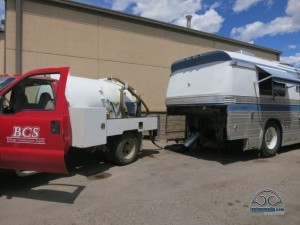
This option had us considering workarounds to minimize our need for the expense – such as getting a weekly rate at the motel next door at over $300/week – but at least we could have unlimited showers. Or, getting a no-contract membership to the gym down the road for access to their showers (if only they had a pool or hot tub on site!)
We put out some feelers, and received the tip to keep calling around – specifically to port-a-potty service companies and residential septic services. A couple calls, and we had a construstion site service company lined up, who was setup for RVs – at a much more reasonable $44 per pump out rate. We can handle that, and that leaves us feeling like we don’t have to be in ultra-conservation mode.
But, we are being somewhat more conservative than we normally would be… mostly so we don’t get caught off guard with full tanks and needing to wait up to 24-hrs to be worked into their schedule.
Our freshwater tank is 90 gallons, plus 10 in the hot water tank. Our black is 45 and our grey 100. Very ample, and without even thinking about it – we regularly go 10+ days between dumps. If we go into more conservative mode, we can extend that even more.
Here are some of the things that are helping us extend our waste tank usage:
- We use the facilities in the shop whenever we can during their open hours. They even have a shower in the locker room that we’ve been invited to utilize if we want a long shower. (And of course by ‘we’, I mean Chris – the locker room is all male, and I strongly prefer using non-public facilities whenever possible.)
-
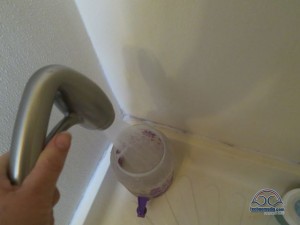
Our fancy cold water reclamation system – a bucket. We have the awesome Oxygenics Spa showerhead – that uses a minimal amount of water, but creates an amazing amount of water pressure and volume by mixing in air pressure. A 1-2 gallon shower feels absolutely invigorating. (And of course, we turn OFF the water when we’re soaping up.)
- We capture unused clean water into a bucket to use for flushing the toilet. Such as the cold water that comes out the shower head while waiting for the hot.
- As we’re both been no-poo for many years (that’s no shampoo, not poo-poo – which would solve the black tank problem) – we don’t need to use lots of water to wash our hair. Just a little baking soda and apple cider vinegar from time to time keeps our hair feeling fresh and clean, and quick rinse other times.
- While we generally try to avoid using disposable products to cut down on what we send to the landfill, we did pick up some paper plates to help reduce the number of dishes we need to wash.
-

Pre-soaking dishes with diluted disk soap. We use a spray bottle with diluted dish soap to pre-soak our dishes. This saves a lot of water in the pre-soak process before scrubbing. We then use a minimal amount of water to rinse our dishes. It takes a little more time in the scrubbing and rinsing, but worth it to extend the time on our tanks.
- We’re very conscious about how far we open any faucet, and try to not keep them open a second longer than needed.
- Kiki is sacrificing too. She loves to drink straight from the under counter filter water spigot. For now, we capture her regular bowl water from her ‘left overs’ instead of filling her bowl separately. She’s not terribly happy that her water has cat-spit in it.. but hey, our drinking water usually does too thanks to her indulgent habit! And instead of dumping her hours old stale water down the drain – that now goes into our clean water reclamation bucket.
For more ideas on conserving water in a RV, here’s some tips we wrote during our trailer living days – where we had only 32G of freshwater on board!
Internet
One of the reasons we preferred Billings to other options was for the solid 4G signal – and that has been working out very well.
We also noticed upon being pulled in here that there was an Interstate WiFi hotspot. The shop was happy to give us a password to it. However, it seems to only work reliably during normal business hours, and mostly goes offline in the evenings and weekends.
Which isn’t so bad – it’s allowed us to do tons of bus engine research during the day and keep up with our daily needs. And we’re able to manage our evening usage between our Millenicom Verizon plan and our AT&T hotspot plan without exceeding our caps. And for our major downloads (such as iOS developer releases), some of the new local friends we’ve made have loaned us a giant cup of fast bandwidth.
Access to ‘Stuff’
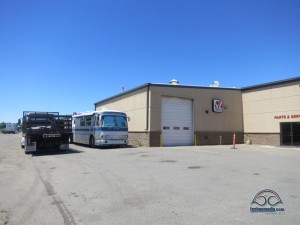
Another consideration when selecting which shop to go with for extended repairs, is investigating how close dining, shopping and things to do are. This stuff is stressful, and also time consuming if you are taking control of the situation and needing to do lots of research and hands on work yourself. Having to go afar to get a quick meals or pick up a few groceries just adds to the stress.
Thankfully, Interstate is on a main road in the Heights of Billings, and we have walking distance access to almost every imaginable fast food joint, several restaraunts, two coin laundromats, a froyo bar, a Walmart, a Target, a grocery store, 6 Redbox kiosks and at least a dozen casinos (?!?).
It’s not as ideal as being in the middle of a mecca of awesome locally owned healthy restaurants & shops, microbreweries and yoga studios (more our style). But, it is nice to have things nearby that don’t take a lot of effort to get to, and Billings is large enough to have a couple Thai & Indian restaurants & large movie theatres across town for when we do have the extra energy.
There’s also fun things around to explore – plenty of hiking trails, the only zoo in Montana, some community theatre and musical events. Yellowstone National Park is also a pretty short drive away, and we’re looking forward to doing some motoring!
Quick Bus Update: Full details coming soon, but the engine is now pretty much disassembled. Two cylinder liners in the lower bank were brittle and cracked, and the rest are showing mild signs of scoring from heat and/or debris. On initial visual exam, the heads, block, cam shaft and crankshaft are all looking intact… more detailed investigation to come this week.
As this week will involve several critical decisions, we’ve decided to forfeit our World Domination Summit tickets and not try to squeeze in a 1800 mile road trip this week to/from Portland. It’s a shame to watch $500/each tickets go to waste like that and we do wish the organization had more flexible ticket transfer policies so we could allow someone else to go in our place.
But sometimes life has other ideas – so in Billings we will stay…

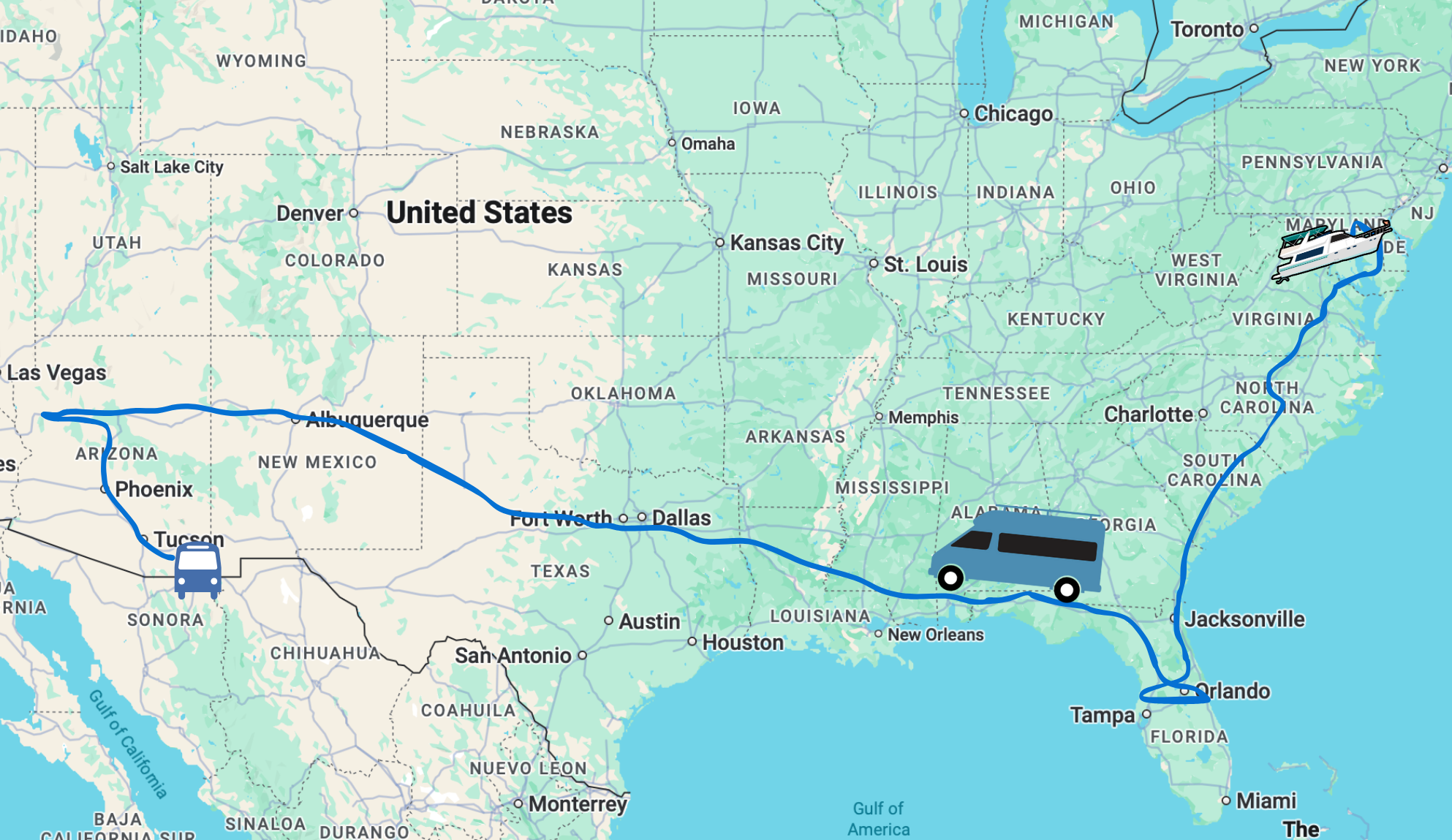
It doesn’t matter if you live in a tiny house as long as you have a loved one to sit beside you. Cheers!
Considering that, in most cases, the motorhome is going to double as someone’s actual home, you really need to be on the lookout for when it will need repairs. I particularly like that the article brings up water and sewer as two big concerns. If your motorhome completely breaks down then you’ll definitely want to make sure that the repair service can make sure that those are working as well.
How much did it cost to get your RV fixed?
A lot… depends on what you call ‘fixed’ however. You can look over our 5-year in a bus review for the details.
This was a fabulous post with tons of helpful info – wonderful!
Under the Towables vs Driveables section, you mentioned staying at a hotel with an outside temperature of 120 degrees. Did the tire company keep your motorhome inside their shop? If not, how did the motorhome and your food survive without A/C?
They were able to run an electric cord to us to keep the fridge going. Given that our bus had lived in AZ for over 50 years, it could survive those heats just fine.
Finally they will ship out tomorrow.
Did you do anything with your engine alternator to protect it from working too hard with the lithiums? Assuming they’re hooked up to your alternator for charging.
Reading the live aboard boater forums it seems some of these guys have burnt up either their alternators or voltage regulators when running their engine if the lithiums were pretty low. Of course charging them first with the generator would solve that problem.
Hi Forest – wow, any ideas why the Balqon cells took so long to ship!?!? How easy have they been to work with and coordinate things with?
As for the alternator – the 50DN alternator in our bus is rated to continuously run at full capacity, so from what I have been told it should not care how much load that the batteries try to put on it. I think many other alternators are not rated for continuous duty, so that might be an issues for some.
I have a 500A contactor controlled by a switch on the dash that lets me bridge in the alternator when desired. This makes it easy for me to take the load off the engine when we are on an uphill grade, or when the battery is getting close to full.
– Chris
I just ordered 4 1000amphour cells to build a 12volt lithium system for my coach. Got them direct from Balqon at a great price. Plan to use my existing Freedom 25 with link 2000 remote for charging. These will replace 6 8D batteries. I’ll just need to buy a SOC meter after I install them. At least I hope that will be all else I need. It’s coming with a BMS system with contactor to shut off the batteries on over/under voltage.
Thanks for your suggestion on the Balqon cells. It was a challenge buying them but it looks like it is working out. At least they took my money 🙂
Awesome guys. Let us know how it goes and how they perform. That’s a setup we’ve been considering when we’re ready for a 1000AH setup.
Hope you guys have a great day and are able to get back on the road once again. Very much enjoy your site and look forward to reading more.
We have a macerator — did you know if you had one with the hose extender, you could just run it into the bathroom at the repair shop and dump? Because of the pumping action the macerators have, you can even run the hoses uphill! It takes a little longer than the stinky slinky, but you don’t sound like you’re in a hurry.
Like we said in the article, if there was a bathroom or sewer intake within a reasonable range of where we’re parked – we would have perhaps proceeded with installing one. But, there’s not – and it’s not like we we don’t have enough projects on our plates.
I’m so sorry to hear of your engine troubles – but how nice it’ll feel to know that your engine will soon be ready for many years of adventures! For a nice day trip from Billings, check out Red Lodge, just an hour away. Beautiful scenery, great hiking, and lots of shops and restaurants. Another lovely place is the Absarokee/Nye area. Nye is 80 miles from Billings, and while there isn’t much there, the scenery is truly amazing! Also, you’ll find some better dining and shopping options in downtown Billings rather than in the Heights. Thanks for your always entertaining blog! 🙂
Hello Cherie and Chris,
We are brand new to the online RV community. We first became aware of your site when we discovered Becky at Interstellar Orchard. We were so enthralled by her adventure that we went back to her very first post to view it (her adventure) in it’s entirety. We also read all of the comments, which is how we found Technomadia. We are about to embark on our own dream quest and hope to blog consistently and honestly about our efforts. Can’t wait to start diving into the well of information you have been so gracious to share. We’re hoping to find folks that can give us input and advice from their own experiences. Not sure if you would mind if we put our blog addy down so we’ll wait till we get a yeah or nay first.
We’ve got a major uphill battle to get through before we officially ‘Hit the Road’ but it hasn’t diminished the excitement one iota.
Best Regards!
k&p Catalano
Thanks for the great thoughts – I really like your idea of having four temperature gauges.
Keep in mind that the engine thermostats don’t even begin to engage the radiator until the coolant reaches 165 degrees, and they aren’t fully open until 185 degrees.
I’ve been warned that overcooling can actually become a problem if you aren’t too careful.
There is definitely a sweet spot to find…
Cheers,
– Chris
You might want to try a water mister for the radiators, just like you use on the windshield. Setup a reservoir and a Windshield Washer pump. Wire the electronics into the drivers console. When you need the extra cooling going up the mountains, you know what to do.
MikeD
A mister is a nice extra boost of cooling to have – I am researching options.
Thanks!
– Chris
To add a little more along the cooling design ideas, I’d like to suggest considering keeping your radiator water at 150 to 160 degrees maximum at the radiator outlet point. This location must be monitored with a temperature gauge and a warning light. If your water starts to exceed 160 coming into the engine cooling jackets, that is the time to take measures to cool down the radiator. I have used this method for my own towing and have not had any problems with overheating. The electric fans can be set to start additional airflow when the radiator outlet water gets to 140 degrees. The engine thermostat will then maintain your desired block temperature and there will always be a margin of safety. If your radiator is supplying water at the engine thermostat temperature and you exceed your high limit, it takes a long time to cool down. My current tow car has 4 temperature sensors, radiator outlet, engine block just before the thermostat, engine oil in the pan, and transmission oil. Single guage with rotary switch. I check all temps about every 30 minutes while towing.
Al
Oh you guys…we were traveling similar routes at almost the same time and WE ALSO USED HANSER’S TOWING (they’re amazing!) when we broke down between Billings and Hardin MT last month (we posted our trek, day by day, on our blog for entertainment purposes).
We are finally home, outside of Glacier National Park, in this amazing free site in the mountains for summer and can’t stop talking about you both as a record heatwave overcomes the west. What doesn’t kill us makes us stronger, right???? Our pets have cabin fever because it is too hot to be outside…and we’ve got a bit of it, too.
Your posts were amazing – yes, tragedy struck, but such is the cost of the freedom we rvers seek. We wouldn’t trade the down for anything….and the ups are so, well, you know!
We recently sold our motorhome for a fifth wheel and pickup, by the way. Love your sharing of feelings about which rv suits you best (and your bus is so gorgeous, we don’t blame you!). For us, the motorhome was much too expensive…a full brake job on one rotor cost nearly $2000…on our truck it cost a few hundred. We had to switch back to towing our home vs driving it for financial reasons. But Zephyr is your baby and worth every penny, a true beauty…and no doubt Zeph will be back on the road soon.
We were in Billings for four days visiting family last month – know “the heights” you refer to, by the way!
Sending positive energy your way – and you are so right, everything that happens was meant to. Whenever we hit that speed bump, we know we’re meant to pull over for awhile…maybe only the universe knows why, but that’s ok with us…we don’t question it.
Try to stay cool, upbeat and strong…the road will be Zephyr’s once more, very soon…and hopefully our paths will cross.
Robin and Jim
Interesting learning about you issues and progress. I have a sligtly off-topic question. I have a MINI that we want to tow and I’d like to know if you have to do anything to the MINI to be able to tow it with all wheels down? My MINI has a manual transmission. What equipment do you use to tow the car?
Thanks!
Rochelle
Hi Rochelle – we actually bought our MINI from fellow full time RVing friend, and they already had the Blue-Ox base plate installed. They said nothing else was required. MINI doesn’t officially support flat towing it, so if you have a warranty still on it – that could be a concern.
Some really great tips in this post, and things I hadn’t thought about in regards to saving water. (I’m going to try the spray bottle idea!) This post reminds me of the two weeks we spent a Tiffin when we first got our motorhome – we did have hookups, but life in a parking lot can be definitely be trying. Glad you’re making the best of it!
Trying our best to!
Pompeys Pillar National Monument is about 25 miles northeast of Billings, Montana, along Interstate 94. It is the only physical evidence remaining of Lewis and Clark’s expedition. Clark inscribed the sandstone pillar with his name and date and it exits today. If you have not been there already, it is an informative place to visit.
On July 25, 1806, Captain William Clark wrote that he climbed the sandstone pillar and “had a most extensive view in every direction on the Northerly Side of the river” (Yellowstone).
It’s definitely on our list for nearby roadtrips should we ever get the opportunity to escape the shop.
It seems like ages ago (was it really only just 3 weeks?) that we were on the Lewis and Clark trail. Hitting Pompey’s Pillar would be a fitting return to those simpler earlier days of our journey west…
Glad to hear that you’re doing OK with your extended shop visit. We were concerned with the same things (living through repairs) when we started and I never imagined that there would be such a difference between towables and driveables. It’s good to hear we made the right choice with a motorhome then. I agree on the toad – I always tow it with a full tank so we aren’t stranded if anything happens to Crush, like a dingy at sea I can’t imagine life without it.
Have a toad definitely has been a whole other level of self independence. (Thankfully, in most situations, they’re not subject to sinking like a dingy at sea might.)
Onward, I hope you are having fun in Montana. As always I enjoy your writting. Cheers, Michael
Thanks.. hoping to get out and explore Montana soon!
I love following your travels via email and facebook. I’m sorry for the problems you’re currently dealing with but I certainly admire the way in which you are handling it. I know that you’re techno types and that must be the work that you do. I own a decorative lighting company that is now 100% online. I have a web site technician in Austin Texas and now we live and run our business from Little Rock. We are looking for a little more expertise and availability from our tech. Do you know Drupal? Would love to talk to you about you guys taking over management of our site.
Thanks
Ed
Thanks a bunch for following along Ed, appreciate having you along.
Also appreciate you thinking of us as a potential candidate for taking over your site. However, we don’t know much about Drupal – and nor is managing sites our line of business. We can barely keep up with keeping this personal blog online 😀 Best wishes in finding someone, and perhaps someone reading this thread will be able to assist?
Thanks Cherie
Hey guys,
Sorry to be making a first reply during your ordeal, I must say we find your outlook encouraging – we hope we can keep the same perspective when we launch the ‘Arthur C Clarke’ into tech-nomad space at the end of this month! To Ed who posted, my wife Jen and I are CMS experts and have tons of experience with Drupal.
Keep your chins up guys, sounds like you are, but we’ll be back in touch soon. Meanwhile, check out the backsplash my wife Jen did in our 34 foot class A – I was super impressed with her work. She details it on her blog at sticky-design.com.
Talk to you soon and we hope all is well!
After 30 years of running Detroits as a boat captain, I was taught many years ago that Detroits should never exceed a water temperature of 185°. At 190°+ they will go into meltdown as the temperatures continue to rise. Just to note that it may help you as we are presently building an MCI-9 conversion. Ours is equipped with a 6V92 Turbo. I found it best to run 170° thermostats along with 24 volt cooling fans on each radiator. The original cooling blower in the compartment is still operational. The fans kick on automatically by thermostat at 180°. When that occurs, a 24 volt red light has been installed to alert the temperature has risen early. As I mentioned earlier, once the Detroit has reached 190°, it is very hard to cool it quick enough with a normal cooling system to prevent damage. The MCI-9 has two radiators, not sure if yours is one or two, but this system would also work either way and I would add every way possible to cool the Detroit down to no more than 180° at any given time. I’ve seen this many times in the marine field and as soon as the engine hits 185°, we would always slow the RPM’s down to around 1000 to cool the engine as soon as possible. Hope this will help you, this is what we have done due to the sensitivity of Detroits and heat building due to their two stroke nature in design.
Thanks for the tips. Please do refer back to our previous posts on what happened – something along the line failed to cause the overheating, this wasn’t just ‘usual’ overheating.
Thanks for sharing your experience. I think the guidelines for land based systems may be slightly different though.
Looking over the GM and Detroit Diesel manuals…
GM recommends warming the engine to 140 degrees before use, if possible.
The driver’s manual says that temperature for most efficient operation is between 160 – 180 degrees, and the engine is considered “cold” below 170 degrees.
The water circulation thermostats start to open at 165 degrees, directing coolant through the radiator. They reach fully open at 185 degrees.
This in the past has been our general standard operating temperature, and even on most hills we hardly budge above this.
The radiator fan starts spinning at full speed once the coolant temperature reaches 172 degrees.
The “Hot Engine” overheat alarm comes on between 210 – 214 degrees, and triggers an automatic shutdown.
One more thing – we have been told repeatedly that the key to keeping the engine cool with an 8V71 in a bus is to keep the RPM’s up close to 2000rpm. This keeps the radiator spinning, and the coolant and oil pumping, as fast as possible – leading to the most efficient possible cooling.
In other words, if your engine is getting hot – downshift and up the RPM’s.
The cooling system on a boat (with an immersed radiator) I imagine is completely different though.
Cheers!
– Chris